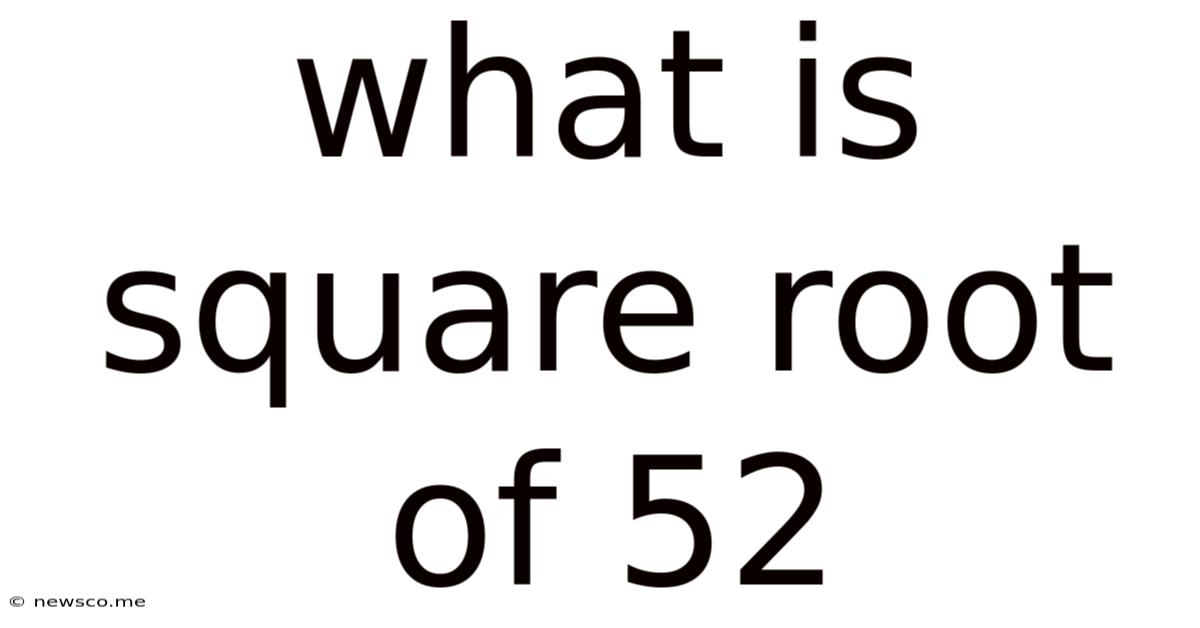What Is Square Root Of 52
News Co
Mar 29, 2025 · 5 min read

Table of Contents
What is the Square Root of 52? A Deep Dive into Square Roots and Simplification
The question, "What is the square root of 52?" might seem simple at first glance. However, delving into the answer reveals a fascinating journey into the world of mathematics, specifically the realm of square roots, prime factorization, and simplifying radicals. This comprehensive guide will explore not only the answer but also the underlying concepts and techniques involved in solving similar problems.
Understanding Square Roots
Before we tackle the square root of 52, let's solidify our understanding of what a square root actually is. The square root of a number is a value that, when multiplied by itself, equals the original number. For example, the square root of 9 is 3 because 3 x 3 = 9. This is often represented mathematically as √9 = 3.
It's important to note that most numbers don't have whole number square roots. The square root of 52 falls into this category. Numbers with whole number square roots are called perfect squares. Examples include 1, 4, 9, 16, 25, and so on.
Calculating the Square Root of 52: The Approximate Value
Using a calculator, we can quickly find the approximate decimal value of the square root of 52:
√52 ≈ 7.211
This is a useful approximation, but it doesn't fully represent the mathematical nature of the square root. To gain a deeper understanding, we need to explore the concept of simplifying radicals.
Simplifying Radicals: The Power of Prime Factorization
Simplifying a radical involves expressing it in its simplest form. This involves finding the prime factorization of the number under the radical sign (the radicand). Prime factorization means breaking down a number into its prime number factors. Prime numbers are numbers greater than 1 that are only divisible by 1 and themselves (e.g., 2, 3, 5, 7, 11, etc.).
Let's find the prime factorization of 52:
52 = 2 x 26 = 2 x 2 x 13
Therefore, the prime factorization of 52 is 2² x 13.
Now, we can rewrite the square root of 52 using this prime factorization:
√52 = √(2² x 13)
Because √(a x b) = √a x √b, we can simplify further:
√52 = √2² x √13 = 2√13
Therefore, the simplified radical form of the square root of 52 is 2√13.
Why Simplify Radicals?
Simplifying radicals provides several benefits:
- Precision: The simplified radical (2√13) is a more precise representation than the approximate decimal value (7.211). It avoids rounding errors and keeps the exact mathematical relationship.
- Efficiency: Simplified radicals often lead to easier calculations and manipulations in more complex mathematical expressions.
- Understanding: Simplifying radicals helps us understand the underlying structure and components of the number.
Exploring the Square Root Function Graphically
The square root function, f(x) = √x, is a fundamental function in mathematics. Its graph is a curve that starts at the origin (0,0) and increases gradually as x increases. Understanding the graph helps visualize the concept of square roots. The graph demonstrates that the square root is always a non-negative value.
Applications of Square Roots
Square roots have widespread applications across numerous fields, including:
- Geometry: Calculating the length of the hypotenuse in a right-angled triangle using the Pythagorean theorem (a² + b² = c²).
- Physics: Determining the speed, velocity, or acceleration of objects.
- Engineering: Solving equations related to structural design and mechanics.
- Finance: Calculating standard deviation in financial modeling and risk assessment.
- Computer Graphics: Used extensively in rendering algorithms and transformations.
Approximating Square Roots without a Calculator
While calculators provide quick answers, understanding methods for approximating square roots manually is valuable. One such method is the Babylonian method (also known as Heron's method), an iterative approach that refines an initial guess to get closer to the actual square root.
The Babylonian Method: An Example
Let's approximate √52 using the Babylonian method.
-
Initial Guess: Let's start with an initial guess of 7 (since 7² = 49, which is close to 52).
-
Iteration 1: Divide 52 by our initial guess: 52 / 7 ≈ 7.43.
-
Average: Average our initial guess and the result from step 2: (7 + 7.43) / 2 ≈ 7.215.
-
Iteration 2: Repeat steps 2 and 3 using the average from step 3: 52 / 7.215 ≈ 7.207. Average: (7.215 + 7.207) / 2 ≈ 7.211.
As you can see, with each iteration, we get closer to the actual value of √52 (approximately 7.211). The Babylonian method demonstrates a practical way to approximate square roots manually, highlighting the iterative nature of numerical calculations.
Higher-Order Roots
While we've focused on square roots (second roots), the concept extends to higher-order roots like cube roots (third roots), fourth roots, and so on. The nth root of a number x is a value y such that yⁿ = x.
Conclusion: Beyond the Simple Answer
The square root of 52 isn't just a simple calculation; it's a gateway to understanding fundamental mathematical concepts like prime factorization, radical simplification, and numerical approximation techniques. By exploring the underlying principles and diverse applications, we uncover a richer appreciation for this seemingly straightforward mathematical operation. The simplified radical form, 2√13, provides a more accurate and insightful representation than the approximate decimal value, highlighting the importance of understanding and applying these core mathematical concepts. Remember, the beauty of mathematics often lies not just in the answer, but in the journey to arrive at it.
Latest Posts
Related Post
Thank you for visiting our website which covers about What Is Square Root Of 52 . We hope the information provided has been useful to you. Feel free to contact us if you have any questions or need further assistance. See you next time and don't miss to bookmark.